Part 5: Dances of Anatolia, the Caucasus, and the Middle East
19 Dances of the Arab Middle East
1. Geography and Demographics
The Arab countries of the Middle East include Bahrain, Dubai, Egypt, Iraq, Jordan, Kuwait, Lebanon, Oman, the occupied Palestinian territories, Qatar, Saudi Arabia, Syria, The United Arab Emirates (UAE), and Yemen. These countries are united by both a language (Arabic and its various dialects) and a religion (Islam). While there are many regional differences within this large consortium of countries, there is also a shared sense of cultural continuity.
Sometimes it is easier to talk about what parts of the Middle East are not part of the Arab world: Iran (where they speak Persian), Turkey (where they speak Turkish and Kurdish), and Israel (where they speak Hebrew), are the only parts of the Middle East where Arabic is not the predominant language. Israel is the only place in the region where some form of Islam is not the predominant religion.
Except for Egypt, which is in northeast Africa, all these countries lie either on the Arabian Peninsula, or just to the north of the Peninsula in the region historically known as the Levant (see figure 1). The Arabian Peninsula is separated from Africa by the Red Sea. It is bordered on the east by the Persian Gulf and the Gulf of Oman, and on the south by the Gulf of Aden and the Arabian Sea. The Levant borders the Mediterranean on the west, Turkey in the North and parts of Iraq and Iran in the east.
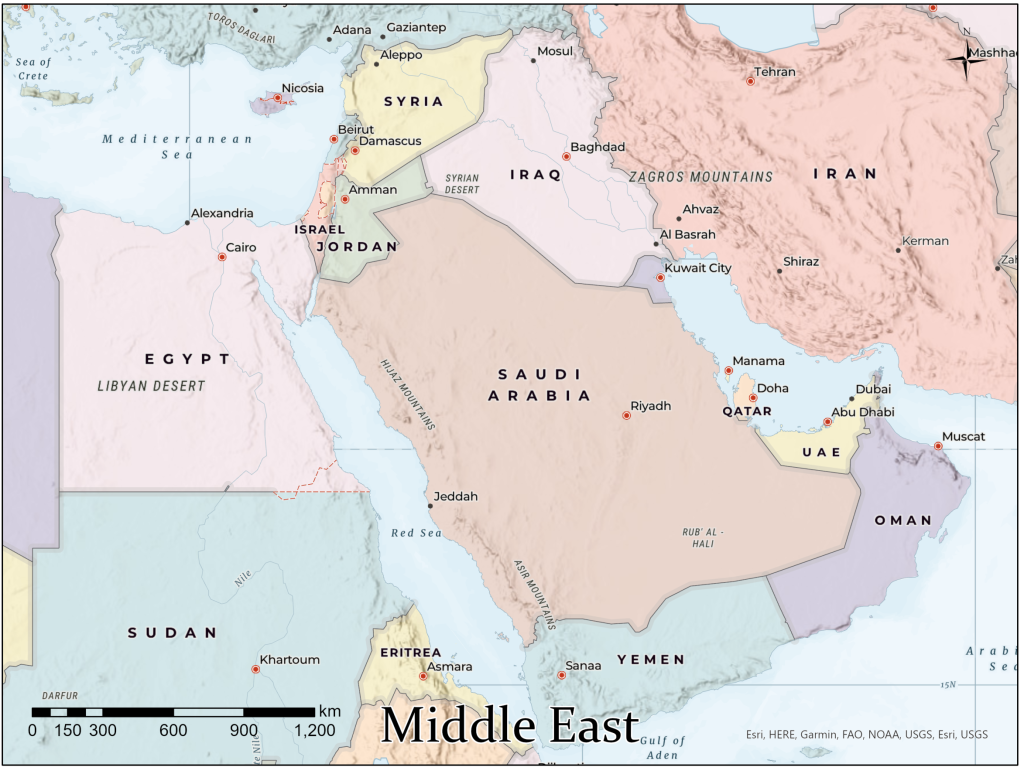
2. History
In ancient times, the Arabic peninsula was variously ruled by the Egyptians, the Hittites, the Sumerians, the Mesopotamians, the Macedonians, the Persians, the Romans, and the Byzantines. In more recent times they were ruled by the Ottomans and European empires like the British and the French. In many cases, these countries were dominated by tribal organization (like those of the Bedouin) or by regional Sultanates and Emirates operating under the colonial system.
The Arabian Peninsula is the place that Islam first emerged and developed into a world religion. While many of its holy sites are shared with Jews and Christians in modern day Israel, the holiest cities for the religion are found in Saudi Arabia: Mecca and Medina. Every Muslim is expected to make a pilgrimage called the Hajj to Mecca at some point in their lives.
The world of Islam is divided into several different sects. The two largest sects are the Sunni and the Shia. These two split apart after a controversy over who was the successor to the Prophet Mohammed. Other sects include the Sufis. One branch of Sufism is famous for their adherents who are known as the “Whirling Dervishes”. The dervishes enter into a trance-like state to get closer to God. They push themselves into this trance by performing a dance where they vigorously spin around the room swinging their heads around in a rhythmic fashion.
While there are some nominal democracies like Iraq, Egypt, and the Palestinian Authority today, the countries of the Middle East are mostly now a hodgepodge of oppressive dictatorships and absolute monarchies. All of these countries have very conservative and religiously oriented politics, and this has led to conflict within the communities (e.g., between the Sunni and Shiite branches of Islam) and between them and their non-Arab neighbors like Iran, Turkey, and Israel. The ongoing conflicts with Israel and the impacts on the Palestinians are discussed in the previous chapter. But there have also been territorial wars between the Arab nations and with Iran. The on-going civil war in Syria is complicated by internal conflicts between government forces, Kurdish rebel groups and the Islamic State terrorist organization. To make things worse, the historical colonial powers and modern superpowers have often used the region as a place to fight proxy wars. The region has a terrible history of violence and terror.
Until the middle of the last century the Arabian nations were all largely poor and tribal, with vast swaths of the region being nearly empty inhospitable deserts. The discovery of oil in the region, however, created a massive shift in wealth. Now countries like the UAE, Kuwait, Saudi and Dubai have some of the richest and most modern cities in the world. Unfortunately, there are also significant disparities in wealth within these countries, where elites live extravagant lifestyles, but many citizens suffer from unemployment and deprivation. This situation has led to thriving extremist organizations that sponsor terrorism both inside their borders and abroad.
3. Clothing and Costumes
When one thinks of dancing in the Middle East, one’s mind immediately jumps to the skimpy clothing used by belly dancers in a sultan’s harem. That stereotype is underlined by the costumes of belly dancers you see in Middle Eastern restaurants in North America and Europe. However, in reality – at least in private social contexts and public venues– traditional dress in this region is very conservative for both men and women.
Women are traditionally covered head to toe, keeping their heads (and sometimes faces) covered. One common head covering for women is called a hijab (حجاب). Other women wear other looser scarves, generically called khimar (خمار). Women sometimes wear floor-length dresses called abayas (عباية), although other modest clothing is common too. For example, in the Levant, women doing debka dancing often wear sirwal(سِرْوَال), which are commonly called “harem pants” in the west. These pants allow them to do high kicking debka steps without compromising modesty (figure 2).
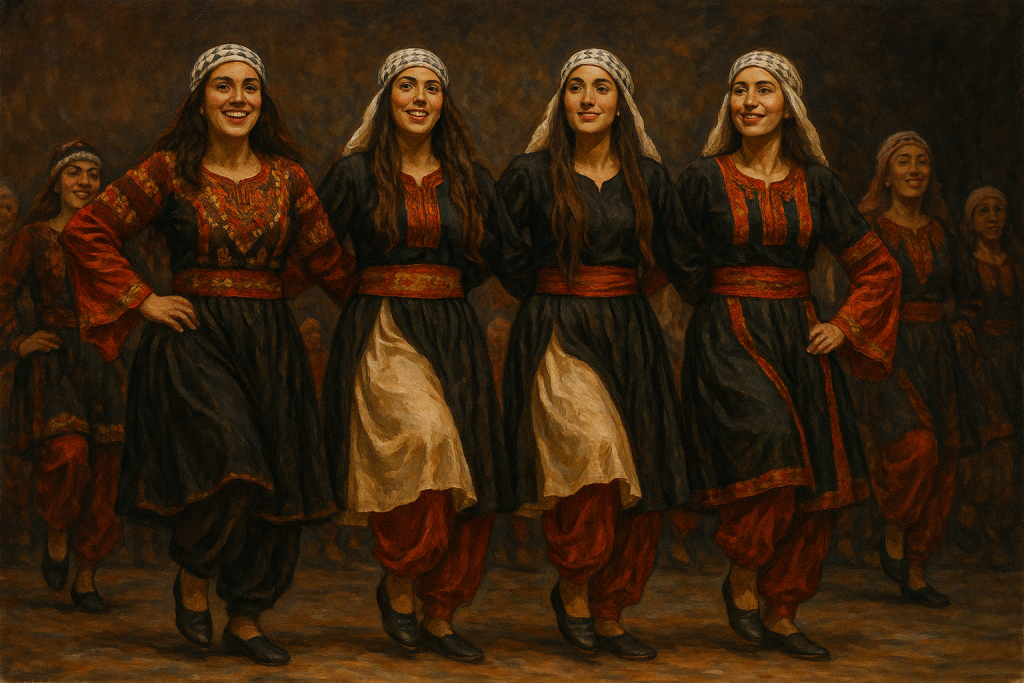
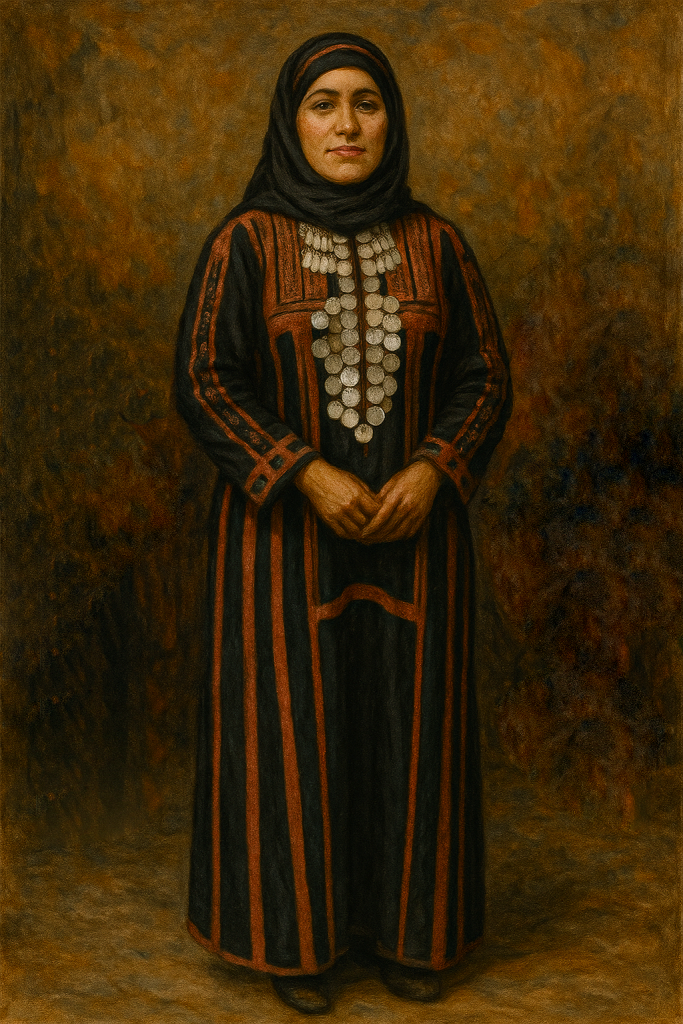
Men also dress conservatively, with little to no exposed skin. The traditional robe worn by Arab men is called a thawb (ثَوْب) (figure 3). Men’s headwear can be anything from a skullcap, known as a taqiyya (طاقية), to a scarf-like head-covering called a keffiyeh (كُوفِيَّة). The corded black circlet atop the man’s head is called an agal (عِقَال) and it is essential for keeping the keffiyeh from falling off the head during walking or dancing.
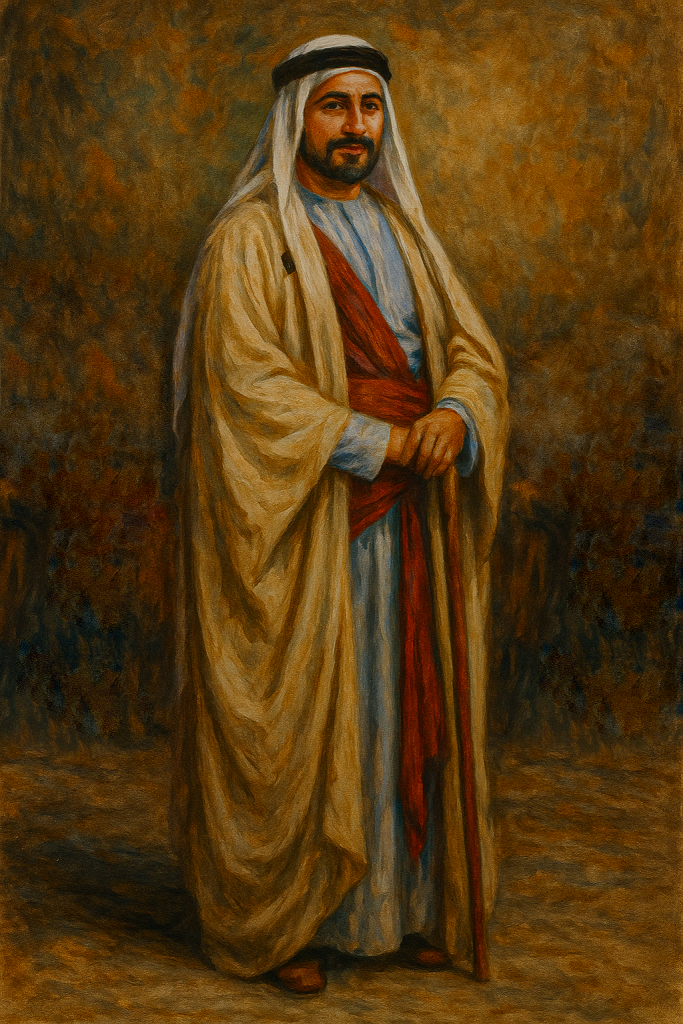
4. Music
Arab music sounds exotic to western ears because it often makes use of different modes and scales than western music. These musical modes, called maqams, come from the classical music of Persia. These scales make use of quartertones not found in western music. Musical Instruments in Arabic music include ouds, a kind of lute; the ney, a flute ;and the qanun, a zither-like instrument. All of these instruments find their correlates in Turkish and Persian music. For percussion, the Arabs typically use a darbuka (also known as a dumbek) and a frame drum called a ta.
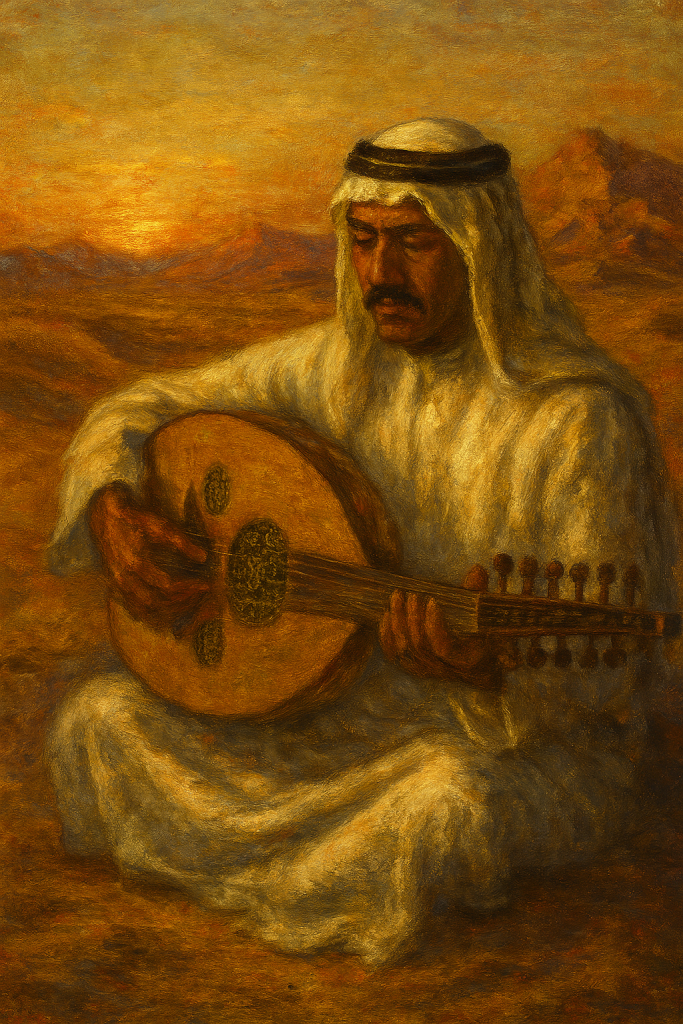
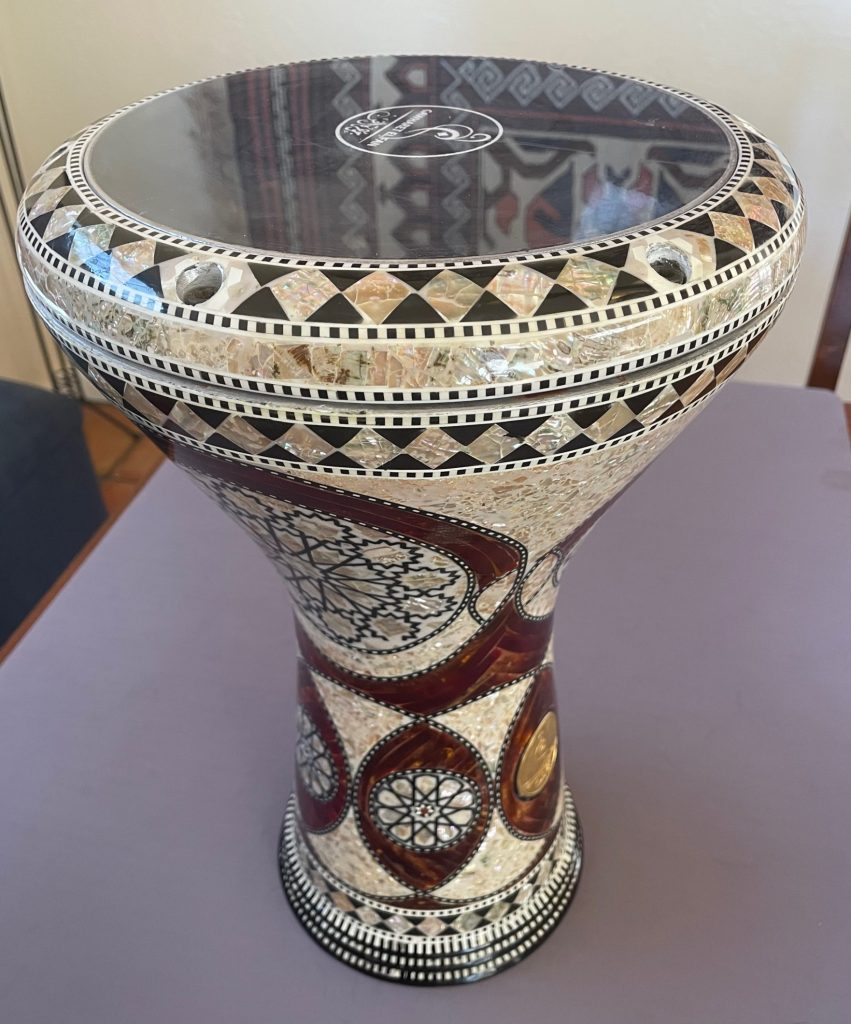
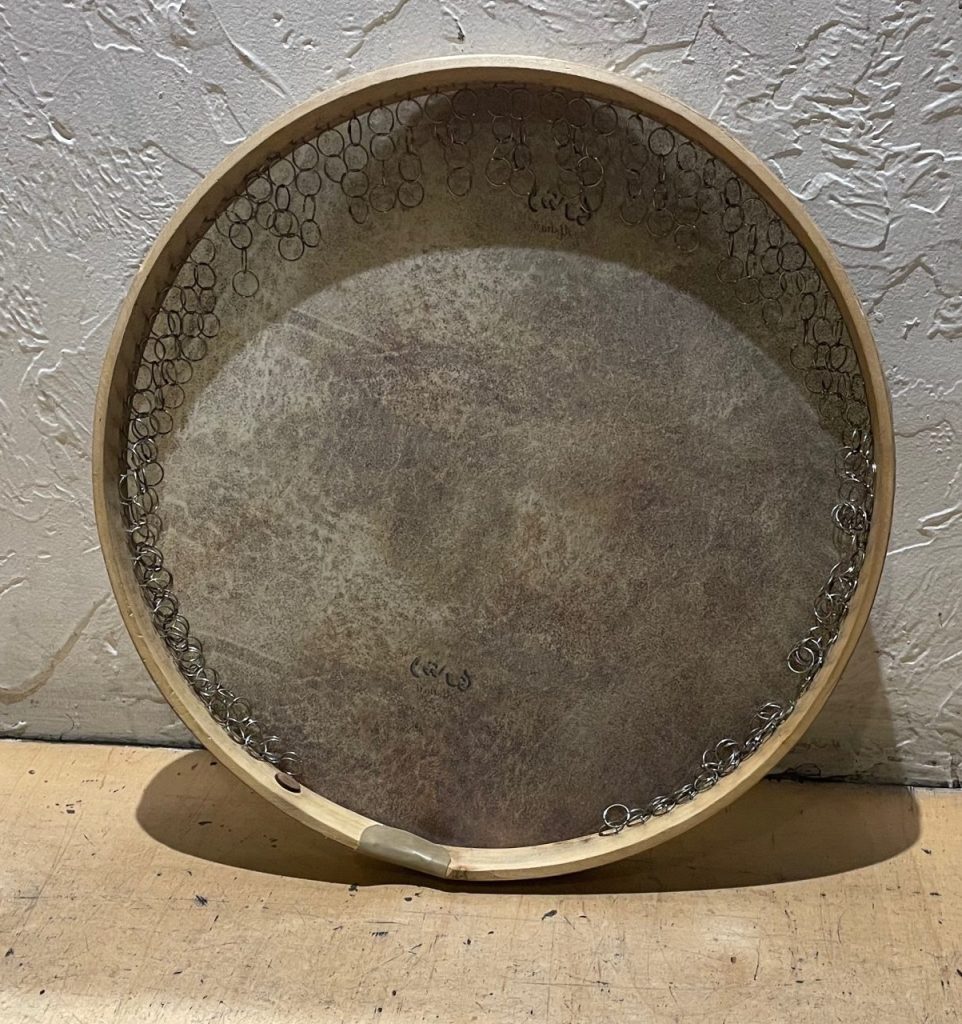
- Arab Pop Music: https://youtu.be/EgmXTmj62ic
- A very good video that explains Arabic maqams (musical scales): https://youtu.be/7psxruQ0EeQ?si=OVTfsrqxRAxOUPaI
- Oud: https://youtu.be/KyNXeCfPB2U
- Ney: https://youtu.be/wYQ_ol3L9Ag
- Qanun: https://youtu.be/xL1QRZ1nfro
5. Belly Dance
The most famous kind of ethnic dance from the Middle East is belly dance. It probably originates in Egypt but was spread throughout the Middle East in the harems of the Ottoman Empire and the Sultanates. There are really two different kinds of belly dance. The first, Raqs Sharqi, is a performance art, which was often done (but not always) for the sexual titillation of the viewer. The second, Raqs Baladi, is much less sexually charged; it is the real folk dance that people do in social situations when they just want to move to the music. The two styles have similar moves, although—of course—the performance form requires much greater skill and athleticism. In some conservative regions, men and women have to dance in separate rooms. Yes, men do belly dance too! In the Ottoman courts, boys were often the performers of Raqs Sharqi.
Raqs Sharqi has a sexualized status not found in other kinds of traditional dance. The dancers, both men and women, wear very revealing clothing. They dance in a way that is meant to seduce the audience. Indeed, Raqs Sharqi is often called “cabaret style belly dance”, because of its functional similarity to cabaret and burlesque dance. Raqs Sharqi performs often dance with props, including veils, fans, canes, spoons, swords and even candelabras. However, the most famous style makes use of small finger cymbals called zils (figure 9).
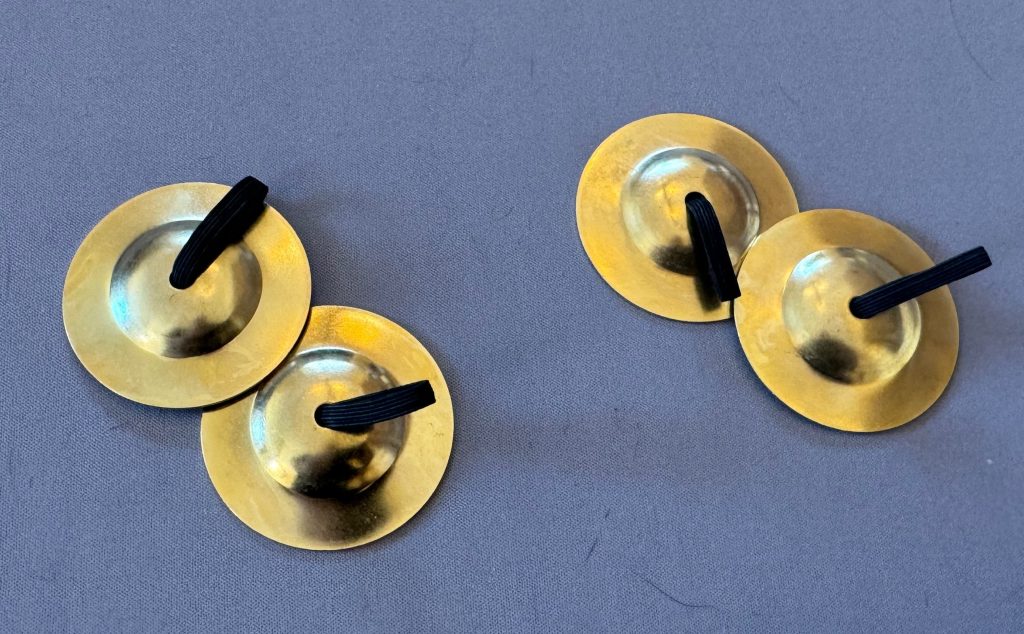
Raqs Baladi, by contrast, is typically done in sex segregated contexts, in non-revealing clothes and is much less highly choreographed. The dancer dances for their own enjoyment rather than for the entertainment of others. The dancers still perform actions that a westerner would identify as belly dancing, such as hip bumps and shimmies with flowing arms. It is thought that Raqs Baladi is the origin of Raqs Sharqi.
- Raqs Sharqi: https://youtu.be/T6NPaSv5gNI
- Raqs Sharqi with a male dancer: https://youtu.be/MlOOUwUtRxk?si=XxZGO_GBj4oRMpvq
- Raqs Baladi: https://youtu.be/M71sT1mZC0I?si=BatHDk5NUrFpKGAn
- Raqs Baladi: https://youtu.be/XW97WXU6yKE?si=VTEgM5xiZUMSXE8K
6. Group Dances
Perhaps the most common type of line dance done by the Arabs is the Dabke. The Dabke is typically done in short lines, where the dancers hold themselves very closely together. It is very common for men and women to dance in separate lines. The Dabke is characterized by kicks and stamps and statuesque pauses, and very small side-to-side movement. The dabke is done particularly by the Arabs of the Levant (Palestinians, Syrians, Jordanians, and the Lebanese), but variations can be found throughout the Arab world. It is the dance done at most weddings and other celebrations. The leader of the line, who determines which variation or figure is being done, often holds a cane, a handkerchief, or a sprig of rosemary.
- Short documentary on Dabke: https://youtu.be/iBRe7QF6re4?si=MydsvzDtyAE0CYjx
- Lebanese Dabke: https://youtu.be/rGN2uWS2iKs
- Lebanese Dabke: https://youtu.be/Fnhd1zXXQWw
- Palestinian Dabke: https://youtu.be/0Zzy_p_Mdos
- Various Dabke Styles: https://youtu.be/9axQZmDfHHw
Another common line dance is the Deheyeh (دحيه), which comes from the Bedouin people. Although done in circles and lines, the dancers in Deheyeh don’t hold hands with their neighbors. Instead, they stand very close to each other, touching shoulders and upper arms. Part of the dance is in feeling the movement of the group through your touching shoulders and not coming apart. Instead of holding hands all the dancers clap in time to the music. The dance also does not typically travel in any direction; it is done in place. Nor does it have complicated footwork. You basically stand in place and bounce and sway in time to the music while not losing contact with your neighbor. There are, however, more energetic movements that can involve foot stamping in place when the music gets livelier and the intensity of the dance increases. The dance is only done by men. The historical origins of the dance were to stir up community members before a battle or a tournament. Another feature of the Deheyeh is that sometimes there is a solo dancer in disguise who comes into the center with a sword or cane and goes around and encourages the dancers to dance harder.
In other parts of the Middle East, you find men’s war dances and women’s spinning or turning dances. Men’s dances often involve brandishing weapons. For example, the Al-bar’ah from Oman involves daggers. The Al Ayalah (also called Yowlah) from Dubai uses sticks and rifles. The sticks represent swords, and the movements of the dance are supposed to be similar to those of a sword fight. A similar dance called Al Ardah is found in Saudi Arabia. The women’s dance Khaleegy that is found in numerous countries around the Persian Gulf involves hand motions that that represent the sea creatures of the gulf.
- Al Bar’ah dagger dance from Oman: https://youtu.be/87h_TNLHRGY
- Al Ayalah from Dubai: https://youtu.be/k8DfMKNWBCE
- Khaleegy from the Emirates: https://youtu.be/ulwR2o6YyEA
- Daheyeh: https://youtu.be/YtFRsAOh3sI?si=cmw38wt2Fk3XKdwe
Further Reading
- Chochem (1948); Chochem and Roth (1941). Corona (1989), Lexova (2000), Nagi (2011), Shay and Sellers-Young (2005). See the references at the end of this book for full citations
Some Suggested Dances for Teaching
- Dabke: https://folkdancemusings.blogspot.com/2008/04/dabke-qamrosh-lebanon.html
- Al Kalaa: https://folkdancemusings.blogspot.com/2022/07/al-kalaa-lebanon.html
- Jeitili: https://folkdancemusings.blogspot.com/2014/03/jeitili-lebanon.html
- Masâr (This is not a traditional Palestinian dance, but it is beautiful and done to hypnotic Palestinian music):https://folkdancemusings.blogspot.com/2020/11/masar-sacred-circle-done-to-palestinian.html
- Zaroura: https://folkdancemusings.blogspot.com/2021/04/zaroura-syria.html
- Shatty Ya Deney: https://folkdancemusings.blogspot.com/2015/12/shatty-ya-deney-lebanon.html
- Ya Ein Moulayeten: https://folkdancemusings.blogspot.com/2021/11/ya-ein-moulayeten-lebanon.html?q=Ya+Hazhal
Discussion Questions
Discussion Question 1
In what ways are the differences between Arabic dances and Israeli dances used to signal ethnic identity? What about the close similarity between the two dance types in terms of music and steps (e.g. the Israeli Debka and the Arab Dabke).
Discussion Question 2
Belly dancing is often thought of as a highly erotic and sexualized dance form, which is surprising, given how traditional and conservative many Arab countries are. Can you think of what the reasons might be for this paradox?
Discussion Question 3
What are we to make of the facts that men do Raqs Baladi and that traditional belly dance costumes cover the body? Are these consistent with the stereotypes of belly dancing?
Media Attributions
- Figure 19.1: Map of the Middle East © John W. W. Powell. Additional geospatial data cited in map. Used here with permission.
- Figure 19.2: Palestinian women’s costume © Saman Meihami, with the assistance of ChatGPT
- Figure 19.3: Bedouin Dress © Saman Meihami, with the assistance of ChatGPT
- Figure 19.4: Man in a Thawb © Saman Meihami, with the assistance of ChatGPT
- Figure 19.5: A man playing an oud © Andrew Carnie, with the assistance of ChatGPT
- Figure 19.6: A darbuka/dumbek © Andrew Carnie, Personal collection
- Figure 19.7: Frame Drum © Howard Yoff, personal collection. Used with permission
- Figure 19.8: Zils or finger cymbals © Andrew Carnie, personal colleciton

